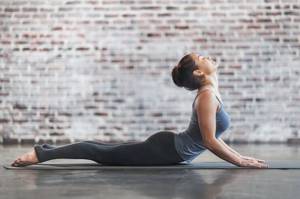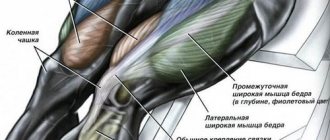Stretching at home for the splits is an integral part of the workout, thanks to which you will quickly achieve the desired result and at the same time maintain your health. In addition, such exercises will improve the condition of the genitourinary system, spine and intestines.
Also, splits are good preparation for expectant mothers (including those who are just planning a pregnancy).
Splits are good preparation for expectant mothers (including those who are just planning a pregnancy)
Psychological preparation
Every person wants to achieve the desired result as quickly as possible. Therefore, a completely logical question arises: how long will it take me to do the splits?
This depends on several factors:
- age;
- gender (girls are genetically more flexible than boys);
- genetics;
- muscle coordination;
- warm-up intensity;
- initial flexibility;
- correct stretching exercises.
Also an important factor is the mindset with which you train. To achieve a similar result, the structure of muscles, ligaments and joints must change in the human body. The duration of this process depends on your age and level of preparation. For example, children will do the splits much faster than adults, since their bodies are not fully formed.
To achieve success, be sure to keep a training diary
Advice! The most important thing to achieve your goal is not to try to achieve the desired result in a day or two. Before each workout, set yourself up for the fact that today you will do all the exercises a little better than yesterday. As a result, you are guaranteed to do the splits.
To achieve success, be sure to keep a training diary. According to research results, this psychological moment, which has nothing to do with physiology, really works. In addition, thanks to the recordings, you will be able to see your progress, which, in turn, will help you not to give up at a crucial moment.
A little theory
Before you start stretching, it is advisable to familiarize yourself with the anatomy of our body and find out which muscles and ligaments are stretched during exercise, what processes occur in the body, and what features the human body has. Knowing all these nuances, you can most effectively influence your muscles.
In addition to muscles, stretching also involves fascia (a special “case” in which each muscle is enclosed), tendons and joints. Some of them stretch, others do not, but have “tolerance” to stretching or are able to open.
Before you start doing stretching exercises at home that will help you do the splits, let's get acquainted with some anatomical features of the body.
Muscles:
- when stretched, the muscle lengthens due to the fact that it grows new segments in its structure. This is a gradual process, so stretching should be gradual so as not to get injured. You also need to do a warm-up before each session - it makes the muscles more flexible and warms them up, making them more susceptible to stretching;
- Strong and trained muscles stretch best. If you have been doing strength exercises and have an athletic body, then it will be easier for you to do the splits. In addition, strong muscles also prevent overstretching and tearing of tissues, making exercises safe;
- The connective tissue in muscle fibers is made of collagen, just like joints and tendons. The ability of a muscle to stretch directly depends on the elasticity of the connective tissue caused by collagen fibers.
Find out how to protect ligaments and joints with collagen and what to do if your muscles hurt after a workout.
Important! To increase the flexibility of the body during training, you can drink a drug with collagen.
Fascia:
- a kind of “bag” in which the muscle is enclosed and which limits its growth and gives it shape. It stretches poorly, but is able to remember its shape;
- with age, fascia tends to contract and restrict muscles;
- constant muscle tone and static tension (for example, due to stressful work or a sedentary lifestyle) lead to contraction of the fascia;
- It is possible to stretch the fascia without prior strength training, but this is a long process. Fascia stretches and grows best when performing strength exercises, when blood flows to the muscles. It is the blood supply that promotes the growth of fascia.
Joints and tendons:
- the joints do not stretch at all, and the ligaments and tendons only acquire “tolerance” to stretching, that is, they become capable of withstanding a large range of movements and stretching without injury, and become elastic;
- the joints do not stretch, but open, and this occurs due to the “stretched” ligaments, which allow the joint to come into a state of opening;
- The greatest opening during splits, especially transverse, is required by the hip joints, while they are the ones that are most susceptible to opening in the human body;
- not all people have the inclination to do the splits, since due to the individual structure of the hip joints, opening is simply impossible. But don't despair, this is not a common case.
Important! There are joints that must not be opened! These are the elbow, knee and cervical: the function of these joints is to provide reliable fixation and mobility, and opening them will make them unstable, which will lead to many problems.
A few more facts about the flexibility of the human body to know how to learn to do the splits at home:
- Men and women have different tendencies towards flexibility - women are naturally more flexible, while men are more inclined to build muscle mass;
- not all joints are equally prone to opening: if one joint opens well, others may be more static;
- large muscle mass is an obstacle to stretching. And vice versa - weak, stretched muscles are prone to injury. The best option is to simultaneously pump the muscles and stretch them, for example, as in athletics. Ideally, you will train your body with strength exercises and stretch it;
- There is a certain range of flexibility to which a person is inclined. Of course, there are people who are able to go beyond this range, but this is facilitated by an innate tendency to flexibility and intense exercise from early childhood. However, most people cannot stretch more than is allowed by nature.
Physical training
To avoid harming yourself when doing exercises, you need to warm up your body and muscles. One of the best ways to do this is a joint warm-up mixed with push-ups and squats at a fast pace. The fact is that such training improves muscle coordination. The effect is so subtle at first, but in the end it will bring enormous benefits.
Let's look at an example. During push-ups, the triceps are involved. However, as you perform, you can feel your biceps tightening. This involvement of other muscles is precisely indicative of poor muscle coordination. The same thing happens during stretching - often these “helpers” prevent you from doing the splits.
To avoid harming yourself when doing exercises, you need to warm up your body and muscles.
To perform joint warm-up in all large joints, you need to perform circular movements at the maximum possible amplitude. Movements are performed 15-20 times in each direction.
Advice! To achieve the maximum effect, you need to perform a joint warm-up from top to bottom: first the cervical spine, then the wrist joints, elbow joints, shoulder girdle, lumbar spine, body, ankle, pelvis and knees.
You can also warm up your muscles by running on a treadmill, cycling and jumping (with or without a jump rope). However, these exercises will not improve the muscle coordination needed for the splits. Therefore, it is best to prepare for exercises with a joint warm-up.
To achieve the desired result, you need to spend at least 30 seconds on each exercise.
What does this look like in practice? At the moment of maximum tension when stretching, take a deep breath and hold your breath a little. As a result, you will feel your muscles giving in and relaxing. When performing the exercises, you must strictly adhere to the written instructions. Follow the golden rule of stretching at home: stretch where it hurts until it stops.
To achieve the desired result, you need to spend at least 30 seconds on each exercise. In this regard, the rule applies: the more, the better. However, every person has a psychological barrier that makes it difficult for him to remain in one position (even in the absence of pain). To achieve the desired result, you need to fight it.
Advice! To get the maximum effect, you need to train in the morning. One hour of stretching in the morning is equivalent to three hours in the evening.
Stretching exercises should be as varied as possible. Often, beginners cannot do the splits due to a couple of unstretched muscles, while their overall flexibility is above average. Even stretching will help you achieve the desired result faster. If you have stretched one muscle group well, it will definitely help when performing other exercises.
Often, beginners cannot do the splits due to a couple of unstretched muscles, while their overall flexibility is above average.
Stretching or stretching and flexibility exercises for beginners
Of course, the process of stretching does not actively promote weight loss, but it actually helps prepare your body for those strenuous forms of exercise (aerobic, strength or plyometric) that will allow you to quickly lose excess weight, as well as improve your range of motion and protect your joints and muscles from possible injuries.
Subscribe to our INSTAGRAM account!
What are the benefits of stretching for beginners?
- Improves blood flow. Performing a set of stretching exercises encourages improved blood supply to all tissues of your body, including the brain. Morning exercises will help you get an extraordinary boost of energy, a high level of concentration, and also prevent fatigue and lethargy after a night's sleep. A good stretching program will involve all your vital organs, including your heart, in active work, relieving it of excess internal tension throughout the day.
- Increases flexibility. Another benefit of stretching is that it significantly improves the flexibility of your entire body by increasing the range of motion of your major joints (hip, shoulder, ankle, etc.). This moment will allow you to move more freely and efficiently.
- Supports a sense of balance. Lack of flexibility in one or more muscle groups can lead to muscle imbalances and, as a result, poor posture. Tight muscles negatively impact the joints, slowly creating a shift from their normal alignment. Connective tissue gradually shortens to adapt to these conditions. All this leads to a situation where the body begins to lose the ability to function at full capacity, which causes frequent injuries.
- Relieves stress. Static stretching can be relaxing, both physically and mentally. Using deep and slow breathing during exercise effectively reduces the feeling of stress, one of the side effects of which is an increase in muscle tension.
- Relaxes muscles. Morning stretching exercises will help make your muscles more elastic, which leads to their overall relaxation. And this is a huge plus! After all, tension in the muscles can lead to the development of discomfort, spasms and pain. And stretching allows muscle fibers to warm up and relax, which significantly reduces the risk of injury during strength training.
- Prepares you for training. If you have another visit to the gym planned for today, start preparing your body from the moment you wake up. Stretching in the morning will prime your body for physical activity and help prevent muscle damage. And they, according to researchers, can greatly improve the overall level of your athletic performance.
- Helps during the rehabilitation period. If you have suffered an unpleasant injury during strength training, then regular stretching will help speed up your healing. But, do not forget that this process must be gradual! That's why it's so important not to overdo it, otherwise you can cause even more harm.

- Increases bone mineralization. In addition to making you physically stronger, proper stretching has additional benefits for your skeletal system. Due to the increased load on the bones, it significantly increases their mineral density, which helps prevent the development of osteoporosis and various fractures.
- Promotes weight loss! And finally, stretching accelerates muscle growth and improves body composition by reducing the percentage of fatty tissue. This is very important, since the opposite process occurs in the body over time, and muscle cells, as we know, due to their metabolic activity, require more energy throughout the day.
Let's do the splits
There are several types of twine:
- longitudinal;
- transverse;
- sagging;
- vertical;
- on hands.
For each of them you need to perform certain exercises.
Advice! The best way to achieve the desired result and improve your health is to move from simple to complex. In other words, you need to first master the longitudinal split, and then begin to study the transverse, sagging, vertical and arm splits. Jumping from step one to step three can cause muscle damage or injury.
Do not tear your muscles under any circumstances, the results will come with time.
Exercises for longitudinal splits
Since the longitudinal split uses the same muscles that work when walking, it is the easiest to sit on. To do this you need to do the following exercises:
Lunge one leg forward and bend your knee so that your foot is perpendicular to the floor. Place your palms on both sides of the floor, keep your head straight, look forward and spring back for one minute. To do this, use your palms and perineal muscles.
While in the pose described above, straighten your body, arch your back, raise your arms and stretch as high as possible. This exercise stretches your legs and strengthens your perineal muscles. Breathing should be smooth and your face should be relaxed.
Place your back leg on your knee while the other leg is perpendicular to the floor. Place your palms (or fists, whichever is more convenient for you) on your lower back and bend back. When performing this exercise, you can throw your head back or keep it straight.
Return to the original position (exercise No. 1). Place your palms on either side of your bent knee, with your fingers facing each other. Stretch your chest toward the floor. When performing this exercise, your upper torso should be parallel to the floor.
Since the longitudinal split uses the same muscles that work when walking, it is the easiest to sit on
Take the same position as in the previous exercise, only stretch your chest and chin towards the floor.
Return to the original position. Gradually bring the knee of your “back” leg closer to the floor.
Advice! When performing each exercise, pay attention to your breathing and technique. Each time you do it better and better, and eventually you will do the splits.
We sit on the cross splits
To master cross splits, do the following exercises:
- Place your feet slightly wider than shoulder-width apart and place your hands on your lower back. Slowly bend back, trying to see your heels. If you place your hands on your stomach while doing this, your abdominal muscles will be additionally worked.
The time it takes for you to do the splits depends on many conditions: initial physical fitness, age, gender, and so on.
- Straighten up, place your feet slightly wider than shoulder-width apart and restore your breathing. Then lean forward so that your back is parallel to the floor. Your arms should be extended (for convenience, you can close them in a lock). Look ahead.
- Spread your legs so that your head and elbows fit between them. Next, bend down and place your palms on the floor. When performing the exercise, do not strain your back or neck. It is also forbidden to bend your knees. Rock back and forth slowly.
- Perform the previous exercise, but using your forearms.
- Stretch your arms up, turn your toes out and spread your legs wide.
- Perform a deep squat. In this case, the back should be relaxed and straight, and the knees should be widely spaced to the sides. Start with 8 sets and increase over time.
- Take the same pose as in the previous exercise. While squatting, hold for 30 seconds and then rise up. Please note: this exercise may not be easy for beginners.
- Perform side lunges. When the exercise becomes easy, grab your ankles and pull towards the floor. Start with 8 sets and increase every 2 weeks.
Some people have open hip joints, so the splits are easy for them. Others need to train for more than a year
- Place your legs as wide as possible and lean forward so that your back is parallel to the floor. In this case, you can lean on your elbows. Watch your breathing: the muscles should tense as you enter, and relax as you exhale.
- Do the same as in the previous exercise. Slowly lower your perineum and stomach to the floor. Once this has been achieved, gradually straighten your pelvis, place your feet on your heels and straighten your back.
Advice! Do not underestimate preparatory exercises - they also have great benefits for the body. You can start mastering the following types of twine only after you have learned how to ideally sit on the longitudinal and transverse ones.
What else is worth knowing?
Once upon a time, ease of movement and mobility seemed completely natural to us.
In this regard, don’t you think that splits are something from childhood? Although, probably not, since you are reading this article. And you're right. Years later, we don’t want to give up, but nothing proves our youth more indisputably than elastic, trained muscles and flexible joints.
Important points
It may very well be that now this task seems overwhelming to you. However, you can always configure yourself so that such a situation only adds excitement.
The main ones, of course, are your perseverance and perseverance. Next, perhaps, we will name age, but we will not exaggerate its significance. Even though you are already well over 40, after 2-3 weeks of constant training you will, even with some disbelief, begin to notice how much easier your movements have become. The number of years only slightly lengthens the path to achieving what you want.
Regularity of training
Like no other athletic task, great stretching requires regularity. The muscles quickly return to their original state. Therefore, how to learn to do the splits if you are lazy? After all, then you will have to constantly start all over again. Ideally, you should not miss a single day. However, the intensity of training may vary.
Moreover, when you start training, you will discover: the muscles do not always behave the same way - sometimes they respond easily to exercise, sometimes they practically refuse to obey. Don't force yourself too actively. Let it be a little careless, but it will happen.
Class time
By evening, the muscles will automatically warm up well from the whole day, and the exercises will be easier. However, don't use this fact as an excuse if morning time is more convenient for you. You just need to warm up better. And if you are interested in how to quickly learn how to do the splits, you need to know some details.
Pain
How can you learn to do the splits without it? After all, pain is an indicator that changes are actually happening in your muscles.
Important: it should not be sharp, but not strong, dull, tugging. If it does happen that you experience acute discomfort, exercise should be stopped immediately and resumed only after the discomfort has disappeared. A common mistake
Common Mistake
While stretching, it is very tempting to keep your back and knees bent. Of course, it’s more comfortable this way! Try not to give in to temptation, warns hudeem-bez-problem.ru, otherwise there will be no effect - the necessary muscles simply will not engage in work.
Effective stretching exercises
Warm-up
Only with a good warm-up will you understand how to learn to do the splits without injury. Walking, running, jumping, squats, straight leg swings are the best preparation for stretching. In addition, it is necessary to stretch the joints by performing rotational movements in the knees and ankles.
Lunges
One leg, bent at the knee, is in front, the other, fully straightened (!), is set back. We perform springy movements - from 10 or more, depending on the condition. Then we change the legs accordingly. Over time, the exercise can be complicated by moving the back leg further and further.
Side lunges and rolls
With your legs spread wide apart, take one of them to the side and sit down on the other. We spring again, focusing on the bent leg and stretching the straightened one. From 10 times on each leg.
Butterfly wings
In a sitting position, we spread our knees to the sides as much as possible, and bring our feet together. Again we gently spring, aiming our knees towards the floor, lightly pressing on them with our hands. We perform from 30 movements.
Bends while standing and sitting
The goal is to be able to press your chest to your knees. This is what we strive for. Don't forget about straight knees and back! We fix ourselves in the maximum possible tilt for as long as possible, and so on 3-4 times.
Leg-split
Of course, this is not a split as such, but rather an intermediate stage. We pull one straight leg forward, the other back and try to stay in the lowest position for at least a minute. Stretching the muscles, slightly sway up and down. It's better to do 2 or 3 approaches.
httpv://www.youtube.com/watch?v=embed/3T39p3l9Cvo
Nutrition
Proper nutrition will also help you achieve your goals faster and strengthen strained muscles. In this regard, one of the best remedies is fish oil. It is also recommended to add Omega-3 and Omega-6 fatty amino acids to your diet. Consume flaxseed oil, nuts and eggs regularly.
Also an important factor is maintaining water balance in the body. You need to drink at least 2 liters of water per day. Add juicy fruits to your diet. To achieve the desired result faster, stop consuming salt. It can be replaced with seaweed, lemon juice, herbs and natural seasonings.
Proper nutrition will also help you achieve your goals faster and strengthen strained muscles.
The list of recommended products also includes:
- carrot;
- nuts;
- spinach;
- meat;
- seafood;
- legumes;
- citrus fruit;
- berries (blueberries, blackberries, cherries and raspberries).
Advice! To prevent inflammation in the joints, add vitamin complexes or foods high in calcium to your diet. At the same time, the body’s recovery should be uniform, so you need to eat protein foods throughout the day.
Summary
Proper stretching at home will help you do the splits. To do this you need to follow the basic rules:
- breathe correctly;
- perform exercises technically correctly and smoothly;
- stretching each muscle group should last at least 30 seconds;
- flexibly stretch;
- exercise in the morning.
Proper nutrition is also an important factor. It is necessary to exclude salt from the diet and add calcium-containing foods, berries, citrus fruits, carrots, nuts and spinach to it.
Before you start training, you need to prepare your body well. To do this, use the same joint exercises mixed with push-ups and squats at a fast pace. As a result, you will improve muscle coordination, without which it is impossible to do the splits.
Another important factor is maintaining water balance - you need to drink at least two liters of water every day
Advice! Even with technically competent execution of the exercises, it is impossible to achieve the desired result if you are not psychologically tuned to the training. The best way to fix this is to keep a diary in which you record your successes and achievements every day. As a result, you will be able to monitor your progress.
And most importantly, don’t compare yourself to others. The time it takes for you to do the splits depends on many conditions: initial physical fitness, age, gender, and so on. It will be better if you compare yourself with yesterday's self. Such measures will help you focus on the results achieved, and not on what is not yet working.
Also, do not forget about good sleep, which is the basis for rapid muscle recovery. Another important factor is maintaining water balance - you need to drink at least two liters of water every day.
How to stretch correctly: simple tips
Warm up before stretching. Of course, stretching exercises are a very important part of the warm-up, but they should not be its only component. Before starting a stretching program, your body must literally warm up, as connective tissue only becomes more susceptible to stretching when it is well warmed up. This will help increase muscle flexibility and elasticity, which will protect you from possible injuries during the main workout.
Experts recommend a 10-minute low-intensity aerobic session as a warm-up, but in general, the actual duration depends on the exerciser's level of fitness. For warming up, it is best to choose exercises such as jumping rope (training with a jump rope with photos and videos) or walking in place (or on a treadmill).
Stretching. When choosing stretching exercises, focus on those that target core areas of your body such as your lower back, shoulders, neck, thighs, calves and abdominals.
Hold each exercise in the program at the maximum stretch point (a feeling of discomfort along the entire length of the muscle, but not pain) for 30 to 60 seconds. Then repeat this element 3 – 4 more times and move on to stretching the next muscle group.
When should you not stretch? Stop performing a set of stretching exercises immediately if you feel a burning or tingling sensation in your limbs, dizziness, muscle spasms, or hear any clicking or crunching sounds.
Now let's get acquainted with the most effective exercises for stretching and flexibility of our entire body.










